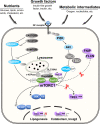Targeting folliculin to selectively inhibit mTORC1: a promising strategy for treating nonalcoholic fatty liver disease
- PMID: 35945199
- PMCID: PMC9363450
- DOI: 10.1038/s41392-022-01111-x
Targeting folliculin to selectively inhibit mTORC1: a promising strategy for treating nonalcoholic fatty liver disease
Conflict of interest statement
The authors declare no competing interests.
Figures

Comment on
-
Inhibition of nonalcoholic fatty liver disease in mice by selective inhibition of mTORC1.Science. 2022 Apr 15;376(6590):eabf8271. doi: 10.1126/science.abf8271. Epub 2022 Apr 15. Science. 2022. PMID: 35420934 Free PMC article.
References
-
- Napolitano G, Di Malta C, Ballabio A. Non-canonical mTORC1 signaling at the lysosome. Trends Cell Biol. 2022;S0962-8924:0117–0119. - PubMed
Publication types
MeSH terms
Substances
LinkOut - more resources
Full Text Sources
Medical

